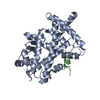Entry Database : PDB / ID : 9f7xTitle Human PPARgamma ligand binding domain in complex with co-activator 1alpha peptide and bisphenol B (BPB) Peroxisome proliferator-activated receptor gamma Peroxisome proliferator-activated receptor gamma coactivator 1-alpha Keywords / / / Function / homology Function Domain/homology Component
/ / / / / / / / / / / / / / / / / / / / / / / / / / / / / / / / / / / / / / / / / / / / / / / / / / / / / / / / / / / / / / / / / / / / / / / / / / / / / / / / / / / / / / / / / / / / / / / / / / / / / / / / / / / / / / / / / / / / / / / / / / / / / / / / / / / / / / / / / / / / / / / Biological species Homo sapiens (human)Method / / / Resolution : 1.63 Å Authors Useini, A. / Strater, N. Funding support Organization Grant number Country German Research Foundation (DFG) 209933838 German Research Foundation (DFG) 421152132
Journal : Biomolecules / Year : 2024Title : Structural Studies on the Binding Mode of Bisphenols to PPAR gamma.Authors : Useini, A. / Schwerin, I.K. / Kunze, G. / Strater, N. History Deposition May 5, 2024 Deposition site / Processing site Revision 1.0 Jul 10, 2024 Provider / Type
 Yorodumi
Yorodumi Open data
Open data Basic information
Basic information Components
Components Keywords
Keywords Function and homology information
Function and homology information Homo sapiens (human)
Homo sapiens (human) X-RAY DIFFRACTION /
X-RAY DIFFRACTION /  SYNCHROTRON /
SYNCHROTRON /  FOURIER SYNTHESIS / Resolution: 1.63 Å
FOURIER SYNTHESIS / Resolution: 1.63 Å  Authors
Authors Germany, 2items
Germany, 2items  Citation
Citation Journal: Biomolecules / Year: 2024
Journal: Biomolecules / Year: 2024 Structure visualization
Structure visualization Molmil
Molmil Jmol/JSmol
Jmol/JSmol Downloads & links
Downloads & links Download
Download 9f7x.cif.gz
9f7x.cif.gz PDBx/mmCIF format
PDBx/mmCIF format pdb9f7x.ent.gz
pdb9f7x.ent.gz PDB format
PDB format 9f7x.json.gz
9f7x.json.gz PDBx/mmJSON format
PDBx/mmJSON format Other downloads
Other downloads 9f7x_validation.pdf.gz
9f7x_validation.pdf.gz wwPDB validaton report
wwPDB validaton report 9f7x_full_validation.pdf.gz
9f7x_full_validation.pdf.gz 9f7x_validation.xml.gz
9f7x_validation.xml.gz 9f7x_validation.cif.gz
9f7x_validation.cif.gz https://data.pdbj.org/pub/pdb/validation_reports/f7/9f7x
https://data.pdbj.org/pub/pdb/validation_reports/f7/9f7x ftp://data.pdbj.org/pub/pdb/validation_reports/f7/9f7x
ftp://data.pdbj.org/pub/pdb/validation_reports/f7/9f7x
 F&H Search
F&H Search Links
Links Assembly
Assembly
 Components
Components Homo sapiens (human) / Gene: PPARG, NR1C3 / Production host:
Homo sapiens (human) / Gene: PPARG, NR1C3 / Production host: 
 Homo sapiens (human) / References: UniProt: Q9UBK2
Homo sapiens (human) / References: UniProt: Q9UBK2 X-RAY DIFFRACTION / Number of used crystals: 1
X-RAY DIFFRACTION / Number of used crystals: 1  Sample preparation
Sample preparation SYNCHROTRON / Site:
SYNCHROTRON / Site:  PETRA III, EMBL c/o DESY
PETRA III, EMBL c/o DESY  / Beamline: P14 (MX2) / Wavelength: 0.9755 Å
/ Beamline: P14 (MX2) / Wavelength: 0.9755 Å Processing
Processing FOURIER SYNTHESIS / Resolution: 1.63→42.23 Å / SU ML: 0.2632 / Cross valid method: FREE R-VALUE / σ(F): 1.34 / Phase error: 41.2329
FOURIER SYNTHESIS / Resolution: 1.63→42.23 Å / SU ML: 0.2632 / Cross valid method: FREE R-VALUE / σ(F): 1.34 / Phase error: 41.2329  Movie
Movie Controller
Controller


 PDBj
PDBj










